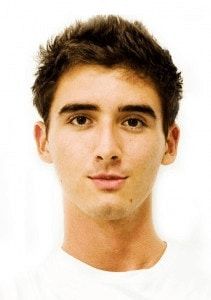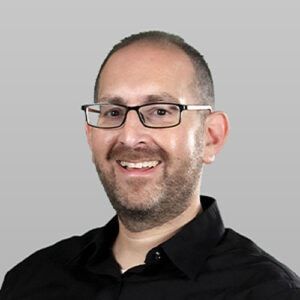In an EXCLUSIVE email interview below, Italian freelance photojournalist Ruben Salvadori tells HonestReporting his views on ethical photojournalism, the role of photojournalists in the Mideast conflict and the effects on the industry.
Salvadori’s revealing video blows the lid on the dynamics between photojournalists and Palestinian stone throwers at the scene.
He exposes how the dramatic images come about and how they distort the reality of the clashes they cover, reinforcing many of the conclusions of HonestReporting’s Shattered Lens, a six-part study of photo bias in the wire services.
Watch Salvadori’s eye-opening video presentation below and then read our exclusive interview where he expands on the issues that his video raises.
Your video describes the characteristics of the ideal photo for editors. Can you elaborate on that? How does that influence the content of the photos?
More precisely, my project describes the characteristics of the ideal photo for the Media market, which goes from the one who produces the image, all the way to the viewer. What we (photojournalists, editors, public) expect form a photograph is a dramatic shot, which simplifies complicated concepts in one single frame. In order to break down a complex situation in just one photo, we are forced to use stereotypes.
The Media has no time, everything has to be immediate, and stereotypes do the job. But the main focus of my project is the fact that the market expects us to produce dramatic images. It’s a very competitive market in which we constantly compare our work to the other professionals’ and therefore produce images that are good according to the taste of other photographers, not of the general public.
The “dramatic” model is pushed by the highest standards of the profession; if you take a look at the major awards in the field in fact you’ll see how they promote a search for tragedy. Take the current Pulitzer Prize winner of the breaking news photography session for example; it clearly states that the winner was chosen for the “up-close portrait of grief and desperation” (Pulitzer Prize Website) or 2009 winner for his “provocative, impeccably composed images of despair” (Ibid).
What’s wrong with editors asking a photographer for certain types of images? What’s the line being crossed?
I don’t think it’s the editor that asks the photographer for a dramatic image. The photographer seeks for drama automatically. This is problematic because many of us tend to over dramatize situations that are not dramatic at all, as you see in many cases shown in my project. What derives from this is a perception of the conflict that is someway distorted from the actual gravity of the events. Additionally, the need for speed in the image-production process does not let the photographer understand deeply what he is photographing to an intimate level. Due to the lack of time, we have to rely on a superficial understanding of the event and its dynamics, and this creates images that are not well rooted in a meaningful context.
This is the main difference between photojournalism and documentary photography, where the former is a fast gathering of news, while the latter is a deeper research within the essence of a topic. Unfortunately there is more business in the photojournalistic world, and we can hardly afford to take the time and money to develop an in depth reportage, which is also harder to sell than single, dramatic spot-news images.
Is collusion a fair word to describe the interaction between the photographers and the stone-throwers?
It is clear that the one’s presence is convenient for the other. They need us to send their message. While there are often tensions between the photographers and the Israeli forces trying to keep us away from the scene, it is very rare to see them between photographers and rioters. It would be against their interest to turn against us and, on the other hand, we need their presence to document the riots, it’s reciprocal. I would not define this a collusion, or a collaboration, as this does not happen on an active and direct way, but I do believe that we both play a role in the other’s interests.

What is a photographer supposed to do when it’s clear that his presence is influencing the actions of the people he’s covering?
First of all a photographer needs to realize this. You’re taking for granted, as I also did, that all photographers believe that their presence has an influence to some extent over the events, but it is a wrong assumption. I was shocked by hearing how many photographers were completely sure that seeing us arriving on the spot in a pack, carrying helmets, gas masks and an average of two big cameras each, had no effect whatsoever on the parties in conflicts.
I think this is the most important (first) step to be achieved, which is the understanding that we have an impact on what we witness, for the simple reason that we are there (let go with all our equipment, I’m talking about being there as any person, not necessarily in the photographer’s shoes).
This is the most basic concept that many other fields have already achieved since a long time ago; look at the “observer effect” in physics, according to which a situation cannot be witnessed without changing it to some extent, or the Anthropology of the 1900s which began already back then to realize how it was not possible to observe another culture without having an influence on it. It’s time that we also realize this. We are there; we are part of the show just like any other one we take photos of.
Acknowledging this is the most important thing a photographer can do about it. We need to be aware of the fact that we cannot seek for the utopian dream of documenting an objective reality. There is no such thing, and we need to get over it. Every photograph is an interpretation of some sort and every time we witness an event we are part of it to some extent. We might not throw rocks or shoot tear gas, but this does not mean we are invisible entities that do not alter the scene.
The next step is not for the photographer. He needs to continue his important work of documenting the events, we cannot do without him. The next step needs to be taken by the public, which generally speaking is lazy and often does not think further than what is being shown. The public needs to approach the photographs with a critical view, being aware of the way the image was produced, checking the source, confronting with others.
I am not pointing an accusing finger against the photographers, this would be hypocritical as I am myself one, and I am aware of the fact that I work according to the same standards of the market. I am not saying that I’m better then others, as some have misunderstood my message. What I am trying to do is to educate the public to be an active observer; I do not have the pretentious aim to change the whole Media giant.
I am also aware of the fact that with this project I raise many questions that I then left unanswered. I think the ethic discourse in the photojournalism world is in such a primordial stage that it is still to early to find all the answers, because we first need to ask the right questions. This is what I attempt to do.
What kind of reaction have you received from the photographers who work these clashes?
There were different reactions depending on the photographers.
Some liked the project a lot and backed me up with great support, while others were strongly against it. I want to point out that some of the photographs were initially uploaded on the Internet with a general caption for all the shots. Since the message I was trying to send was beyond the single frame content, I was strongly criticized for doing the unprofessional act of using the same general caption for more frames.
“You claim that we influence the events, so you need to show it in the photograph” was one of the comments that I mostly remember, “show the photographer telling a boy to pose for the camera”. This was clearly missing the point, as influencing an event does not mean actively manipulating it. Others said that the photographs are not good at all, that anybody could have taken them. And this was one of my aims, to produce non-dramatic and non-over “aestheticised” photographs. But many would argue that a photo without drama and some vignetting is just another “Facebook picture”.
Other than this the project is having a huge success recently both among the professionals and the general public. It was an award winner at the PhotoDreaming Contest, organized by Forma, an institution founded by Contrasto, the major Italian photo-agency that deals with a deeper documentarist side of visual research. Moreover the video of the presentation had a massive amount of views, reaching a peak of more than 18 thousand hits in just one day. I was also contacted by different organizations to lecture about the topic on University campuses in Italy, U.S. and Canada.
Now that you’ve spoken out, do you still have a future working in the Palestinian areas? Where do you go from here?
I must say that I’m very curious to see what it would be like to go back. Some told me that I shot myself in the leg if I wanted to work as a photojournalist in Israel, but fortunately this is not my plan. My main interest is anthropology, and I use photography as a way to satisfy my curiosity for human behavior. I approached the topic of my project with an anthropological method and I think this is what gave me the tools to analyze the issue in a “different” way.
At the moment I’m taking a short break form my studies (I just graduated). I will use this year to work on projects for which I haven’t had the time so far, like a documentary of visual anthropology that I’m making. For next year I’m considering a master degree in documentary cinema, but we’ll see where this year takes me. I would like to expand the project on photojournalism to other areas of conflict, if I find funds, connections and time.
You can find updates on Ruben’s website www.rubensalvadori.com or on his blog www.rubensalvadori.wordpress.com
Please help spread the video above so that the important issues covered start to enter mainstream consciousness.


